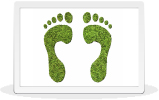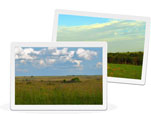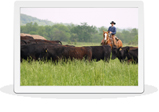-
Going Beyond Sustainability Is Better

At Tallgrass Beef, we have coined a term for the way we raise our cattle—Beyond Sustainability. It means that we aren't content with simply being carbon neutral or not harming the earth. Instead, we raise our cattle in a way that actually improves and enhances the world we live in.
-
Growing Grass Is Better

We're all worried about how we can reduce our carbon footprint. The farmers and ranchers of Tallgrass Beef contribute daily to the reduction of carbon in our atmosphere through the simple process of growing grass. Grass removes carbon dioxide (CO2) from the air and uses it to grow. The grass above ground is eaten by our cattle, but the CO2 used to grow the roots is held in the soil. This is called carbon sequestration, and it's the process that produced, through the centuries, the deep, rich soil of the great American Grasslands. This natural process of cattle grazing on open pasture can be used to clean carbon from the air released from fossil fuel burning, and put it back underground as part of the soil.
-
Not Growing Corn For Feed Is Better

Grain-fed cattle require the growth of millions and millions of acres of corn. While grass is a perennial that comes back again and again with no new planting and is simply eaten by the cattle where it grows, corn is an annual that must be newly planted each year and then harvested and converted to feed. Every step in the development of corn as food requires using energy to operate machinery, and that means burning fossil fuels and adding more carbon to the atmosphere.
-
Adding Less Nitrogen To The Soil Is Better

Tallgrass Beef pastures are fertilized only with the natural wastes produced by the cattle. We use no artificial fertilizers that contain nitrogen, which can, over time, actually harm the soil. We also use no herbicides on our pastures, except those mandated by the state of Kansas to battle invasive weeds.
-
Careful Land Management Is Better

We use a technique called "mob grazing" that allows the animals to completely graze one area before moving on to the next and helps improve the quality and diversity of the grass that grows back. This provides the cattle with a better diet and allows the land to recover fully from grazing, helping conserve it for long term use.




